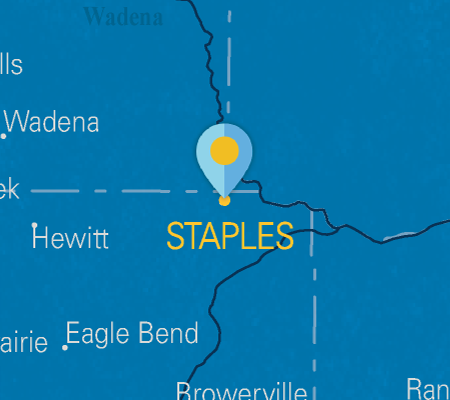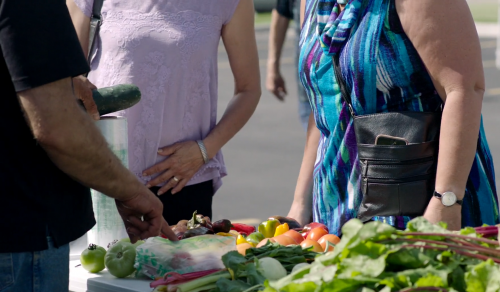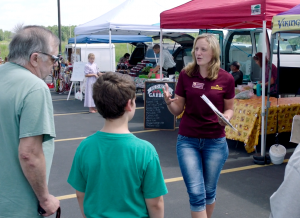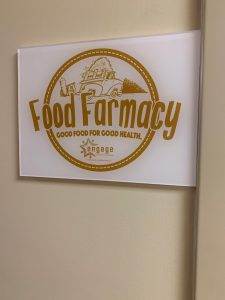
From Farm to Families: Lakewood Health System Brings Healthy Food to the People
Once a month, the seniors at Humphrey Manor in Wadena, Minnesota, eagerly await the arrival of the veggie wagon. That’s when they each get a bag of fresh, local vegetables delivered right to their doorstep courtesy of Lakewood Health System’s Fresh Delivered initiative. It’s one of many ways Lakewood Health is getting fresh, healthy produce to area residents to improve overall health.

Lakewood added a SNAP-benefits matching program to the Farmer’s Market that they host every week during the summer.
Growers and health care providers meet to package up in-season fruits and vegetables into healthy eating care packages. The Fresh Delivered truck, or “veggie wagon,” brings them to several senior-living buildings in the area. Seniors are the fastest growing population in rural Minnesota, many of whom don’t have transportation to get to a grocery store. So the Veggie Wagon comes to them.
“It’s just a real blessing and it’s something we look forward to every other week,” resident Linette Winger says.
The Lakewood Engage Program
The Fresh Delivered initiative is part of the Lakewood Engage program that began in 2016 after Lakewood’s Community Health department conducted a needs assessment of the Staples area, and determined its rural-living residents, despite being surrounded by rich, fertile farmland, were struggling to access healthy foods. It was affecting their overall health, producing an increase in diabetes, hypertension, heart disease and mental illness.
“We have a lot of rural residents who have to travel many miles to access healthy foods,” explains Alicia Bauman, Director of Community Health at Lakewood Health System. “Often times, the closest food access point is a gas station.”
Affordable and accessible
40 percent of the population in the Staples area and surrounding counties live below the poverty line, making fresh fruits and vegetables difficult to afford. To help, Lakewood added a SNAP-benefits matching program to the Farmer’s Market that they host every week during the summer. The Hunger Solutions matching market bucks program allows any SNAP participant to double their buying power every time they come to the market.
“So a ten dollar investment of SNAP dollars actually buys them twenty dollars of locally grown foods,” Bauman says.

The University of Minnesota extension service gives a guided tour of the farmer’s market.
They partner with the University of Minnesota extension to provide market tours to educate people about the available food, how to shop on a budget, and how to stretch their dollar. Tours include a booklet with nutrition information as well as recipes and ways the foods at the market can be prepared.
Meeting a critical need
Bauman says it’s not uncommon for residents to show up at the emergency room because they’re hungry. Lakewood has a solution for that, too, and have integrated a screening process to identify food insecurity.
“Hunger has many implications on health and well-being, not only within that chronic disease space – diabetes, hypertension, heart disease – but really on the social health space, too,” Bauman says.
When a need is identified, health care professionals have access to resources such as acute care packs with 72 hours’ worth of food items and recipe cards to help participants use the contents of the box.
Healthcare professionals can also refer patients to the Food Farmacy for individually tailored interventions that can include a health coach, cooking skill development and budgeting education.
More than 800 people are served monthly with more than four tons of food.

A Shift in Focus
Lakewood’s efforts are getting much-deserved recognition. Blue Cross and Blue Shield of Minnesota recently named them a Trailblazer for their food access initiatives, which have been shown to reduce emergency room visits, improve quality of life and improve mental health.
“Lakewood identified a way to positively impact community health by looking at what’s necessary to create wellness versus just treating illness,” says Craig Samitt, President and CEO of Blue Cross and Blue Shield of Minnesota. “This innovative shift deserves recognition. We see this as a model program worthy of replication across the state.”
Research has shown that only 10 percent of health is determined by what happens in traditional clinical settings such as doctor’s offices and hospitals. Another 10 percent can be attributed to genetics. But the remaining 80 percent of health is driven by surroundings, often referred to as social determinants of health. In order to move the needle toward wellness, it’s important to address people’s ability to achieve good health, including physical environment, behaviors and socio-economic factors.
“There is no better example of how we can improve health by addressing social determinants than what Lakewood has done here,” Samitt says.
“We never let challenges stop us from being innovative and finding ways to help the community,” says Tim Rice, President and CEO of Lakewood Health System. “People ask, ‘What about money?’ but that’s the last thing we talk about. To me, if it’s the right thing to do, we will find a way to get it done.”
To learn more about Lakewood Health’s Engage program, visit: LakewoodHealthSystem.com.
